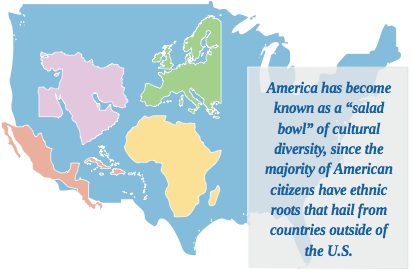

America has become known as a “salad bowl” of cultural diversity, since the majority of American citizens have ethnic roots that hail from countries outside of the U.S. Within multicultural America, many have observed and respected each other’s cultural practices, fashion and foods, but tasteless under tones of social negativity are still apparent in some cases. This kind of demoralizing behavior against another human being is unacceptable, especially in the workplace. Fortunately, there are practices that can help maintain the positive morale of all employees by keeping the underlying characteristics of negative prejudices at bay.
To begin, understanding how to navigate diversity in the workplace requires knowing what it means. According to “Define Diversity in the Workplace,” an article posted in the Houston Chronicle, diverse workplaces are composed of employees with varying characteristics including, but not limited to, religious and political beliefs, gender, ethnicity, education, socioeconomic background, sexual orientation and geographic location.
There are many benefits to building a diverse workforce aside from driving economic growth. Reports by Kerby S. Burns posted on the Center for the American Progress website, an institute dedicated to improving the lives of Americans through progressive ideas and action, suggests that diversity in the workplace captures a greater share of the consumer market; builds a more qualified workforce; helps businesses avoid employee turnover costs; fosters a more creative and innovative workforce; and creates a competitive economy in a globalized world. Furthermore, diversity in the boardroom is needed to leverage a company’s full potential.
Nevertheless, many issues can challenge the creation of a cohesive, diversely staffed work environment due to ineffective communication, perceptual, cultural and language barriers, and resistance to change.1 However, solutions to problematic issues like these do exist.
To initiate or maintain a successful diverse work environment, multiculturaladvantage.com, an online community that provides timely coverage of workplace issues and trends relevant to underrepresented professionals, recommends warding off resistance to change with inclusion; fostering an attitude of openness in your organization; promoting diversity in leadership positions; utilize diversity training; and launching a customizable employee satisfaction survey.
The article “5-Strategies for Dealing with Diversity in the Workplace” posted on Chron.com offers strategic advice for dealing with diversity in the workplace:
- Recognition: celebrate the differences among your employees, and encourage them to let their individualities show
- Fairness: treat people fairly and respect the differences that make them who they are
- Focus on Yourself: Diversity is an issue that you must manage in the workplace, and it starts with managing your own attitude and behavior including body language and style of oral communication in interviews with people of different ethnicities
- Employee Assessments: examine your employees’ attitudes, particularly how they work with others outside of their ethnic composition
- Encourage Interaction: encourage employees to work with others of different backgrounds or generations. Initiating these types of interactions encourages your employees to learn more about communication styles, talents and goals.
Sustaining a successful diverse work environment can also require successful methods such as education initiatives that focus on how different cultures demonstrate their principles and beliefs. A very important mindset, according to Lynne Lee, human resources manager at PreGel AMERICA, is, “You have to remain open-minded and conscious of everyone’s differences from the big events down to email.”
Documented in the article “The Top 10 Economic Facts of Diversity in the Workplace,” published by www.americanprogress.org, “diverse workforce combines workers from different backgrounds and experiences that together breed a more creative, innovative, and productive workforce… In this way, diversity is a key ingredient to growing a strong and inclusive economy that’s built to last.”
In general, today’s diverse workplace is an environment composed of generations of varied Americans from differing religious and political beliefs, gender, ethnicities, educational levels, socioeconomic backgrounds, sexual orientations and geographic locations, proving that tolerance, acceptance and overall respect for human difference is possible when working in tandem toward the age-old, liberating goal of prosperity.
Resources and Further Reading:
1Greenberg, Josh. (2009) TheMulticulturalAdvantage.com
Diversity in the Workplace: Benefits, Challenges and Solutions. retrieved January 2013 from http://www.multiculturaladvantage.com/recruit/diversity/Diversity-in-the-Workplace-Benefits-Challenges-Solutions.asp
Brookins, M. (2013). Chron.com. Define Diversity in the Workplace. retrieved January 2013 from http://smallbusiness.chron.com/define-diversity- workplace-4926.html
Kerby, S., Burns, C. (2012). Americanprogress.org TheTop 10 Economic Facts of Diversity in the Workplace: A Diverse Workforce Is Integral to a Strong Economy retrieved January 2013 from http://www.americanprogress.org/ issues/labor/news/2012/07/12/11900/the-top-10-economic-facts-of-diversity- in-the-workplace/
Ryan, Tom (2012). Chron.com 5 Strategies for Dealing With Diversity in the Workplace. Retrieved February 2013 from http://smallbusiness.chron.com/ 5-strategies-dealing-diversity-workplace-18106.html
